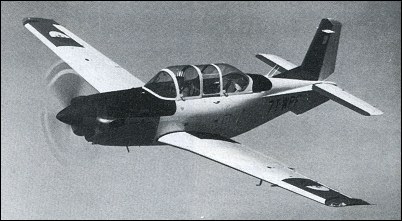 |
Beech Model 45 Mentor / T-341948 |  |
| TRAINER | Virtual Aircraft Museum / USA / Beech |
 |
In 1948 Beech built as a private venture a two-seat trainer evolved from the V-tail civil Bonanza. It differed primarily by having tandem seating for pupil and instructor, and by the substitution of a conventional tail unit for the V-tail. This aircraft was designated Beech Model 45 Mentor, and flew for the first time on 2 December 1948. At about this time the USAF, in common with many other air forces, was trying to make up its mind about the trend of future primary training. The problem facing them all was whether or not, as a result of the introduction into service of turbine engines, initial training should be on jet-powered aircraft. At the time it was a difficult question: an affirmative answer meant not only that the most ham-fisted of student pilots would have to cope from the outset with aircraft of much higher performance, but that at the same time they would be faced with the problem of handling a power unit which had not then been developed to a point of great reliability. On the credit side, however, they would work throughout their training with turbine engines and a constant handling technique: retention of piston-engine power for primary trainers would bring the need for a transition phase from piston- to turbine-engine at a later stage. USAF planners chose the latter as the mor-e prudent course afthat time. Among the various types evaluated were three examples of the Beech Model 45, two powered by the 153kW Continental E-185-8 engine and one by the 168kW Continental E-225-8; all three were designated YT-34 by the USAF. These three aircraft made their first flights in May, June and July 1950, and were tested extensively during the competition period, being flown not only by evaluation pilots, but also in the primary training role with pupils and instructors. Almost three years later, on 4 March 1953, the USAF selected the Model 45 as its new primary trainer, under the designation T-34A Mentor, and ultimately 450 were built for that service, 350 by Beech and 100 by the Canadian Car & Foundry Company in Montreal, Canada. US Navy evaluation of the Model 45 began soon after the USAF had placed its initial contract with Beech, and on 17 June 1954 the Navy ordered 290 of these trainers, under the designation T-34B. A total of 423 was acquired eventually. In July 1951 one of the original prototypes was modified to mount two 7.62mm machine-guns in the wings, with provision additionally for underwing racks capable of accepting six rockets or two 68kg bombs; this was evaluated by the USAF as a potential light close-support aircraft, but no orders materialised. Not surprisingly, in the jet age, most piston-engine trainers were gradually phased out of service, being replaced by sleeker, purpose-built jets which formed the first component of an all-jet training scheme, from ab initio to the moment when the pupil was considered fit for posting to an operational squadron. The US Navy decided in 1973 to investigate the possibility of retaining the tried and trusted Mentor in service, with its piston engine replaced by turbine powerplant. Such a scheme offered a continuity of experience with the Mentor airframe and its excellent handling characteristics, and would provide the pupil pilot with an unbroken sequence of turbine-engine handling throughout his training. To evaluate this proposal, the USN instructed Beech to convert two T-34Bs to turbine power, under the designation YT-34C. The powerplant chosen by Beech for the conversion was a Pratt & Whitney Aircraft of Canada PT6A-25. In this particular application it is provided with a torque limiter that restricts power output to some 56 per cent of maximum, ensuring constant performance over a wide range of altitude/temperature conditions, and also offering long engine life. The first YT-34C was flown on 21 September 1973, and following satisfactory evaluation of the two aircraft, Beech received contracts valued at approximately $72 million for the construction of 184 new aircraft. In addition to the installation of the new engine, the production aircraft were also given structural strengthening to ensure an airframe fatigue life of some 16,000 hours. The first T-34C Turbo-Mentor entered service with the USN's Naval Air Training Command in November 1977, and student training with the type began during the following January. Since then production has reached 353, with six being transferred to the US Army. Subsequently, Beech developed a T-34C-1 version for armaments system training, equipped with four underwing hardpoints having a total weapons capacity of 544kg. In addition to deployment in such a training role, the T-34C-1 is suitable also for forward air control and tactical strike training missions. Examples of this version have been supplied to the navies of Argentina, Ecuador, Peru and Uruguay, and to the air forces of Ecuador, Indonesia and Morocco. An export civil version, known as the Turbine Mentor 34C, has also been delivered for use in Algeria's national pilot training school.

|  COMPANY PROFILE | ||||||||||||||||||||||||||||||||||||||||||||||||||||||
 |

|

